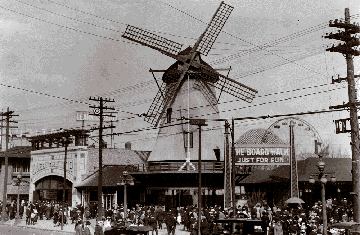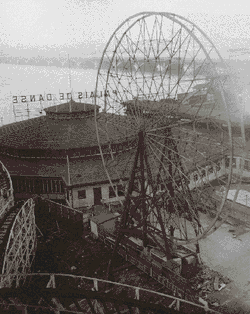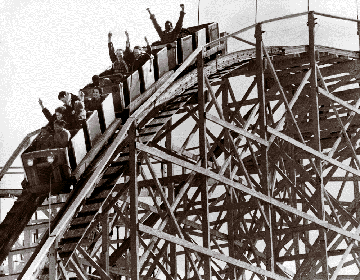Detroit's amusement parks
By Patricia Zacharias
"We would walk up to the park and look through the fencing at the lights. We could could hear the music and laughter. Admission was 10 cents and we were poor. But even from the outside looking in, Electric Park was magical."
--Marguerite Christie, Age 80.

Long before the advent of mega theme parks, amusement areas like Electric Park and Edgewater Park were generally raucous gatherings of roller coasters, fun houses and other concessions. Although Coney Island set the standard, the Detroit shoreline was not far behind as a destination for immigrants hungry for entertainment.
Electric Park, Detroit's first mammoth amusement enterprise, opened May 26, 1906, near the Belle Isle Bridge approach. The Free Press heralded the opening of the park, "Detroit's new Electric Park will be one of the largest in the world. Rome, with its seven hills will be a poor second to the roller coaster which is to be installed on the western site of the park. Here will be found l4 hills and any amount of hilarious fun my be derived within the enclosure."
Owned by the Arthur Gaulker family, Electric Park, before it closed in 1928, went through many name changes and lengthy court battles over property rights. Some oldtimers remember the park's nicknames: "Pike's Peak, Lunar Park, Riverside or Granada." Many of these names came from concessions located along the riverfront grounds.
According to a News article on the Grand Opening, "the first attraction offered will be the Great Chick, tramp cyclist and comedian. Chick is well known as 'the funniest man on wheels'. Mlle. Patrice, a well-known and clever performer on the flying trapeze and Spanish web, divides first place with Chick as the headline attraction. Mademoiselle's work is said to be a finished and graceful performance. Her dizzy descent from a high platform via the hair raising 'Spanish Web' is a thriller. Music lovers will welcome the return of Miss Nellie Turnbull, soprano, who tours with the Rosati Royal Italian Band."

A favorite attraction was a scale model of the horrible flood of 1889 in Johnstown in Pennsylvania that killed thousands. Other attractions included aerial and high-wire acts. The Big Dipper, the Bobs, and the Dare Devil were roller coasters for the brave.
Queen of the ballrooms was the Palais de Danse, built over the water by Charles Rosenzweig in l9l2. Memories of its dance floor still bring nostalgic twinges to those who flocked to "The Palais". Famous bands like Sousa's and Creatore's came to play there.
Palace Gardens, another dance hall associated with the amuse ment park, burned down in May 1911 at a loss of $130,000. In February 1921, the Coliseum and Pier, the largest concession on the riverfront was destroyed by fire.
In 1927, after long and bitter legal battles, Electric Park's amusement centers were condemned by the city as eyesores. They were razed in 1928 to make way for a public park, considered to be a more suitable approach to Belle Isle. The area was officially renamed "Gabriel Richard Park" in 1936.
As the wrecker's ball felled the riverfront attraction, another park was being erected on the "Grand River"...Edgewater Park!
"During my teenage summers I would get up at 5am on Saturdays and start washing cars...anyone's cars: my mother's, my father's, my brother's, and any neighbors' who were willing to pay," said Laurie J. Marzejka. "When I had earned enough I would shower, change into a shirt, shorts, sandals, and shades and head-out to Edgewater Park. I would spend the entire day with friends enjoying sunshine, snowcones, and slow-poke suckers all amid screams of delight."

"Nothing could be better than to take the Livernois/Grand River bus to Edgewater Park on a hot summer Saturday or Sunday," said Dennis Kreish. "Cotton candy, thrill rides, and lots of people. It was the early 60's. We would leave around noon. Usually the four or six of us, Roman, Mark, Kathy, Diane, Barbara and myself would wait at the corner of Livernois and Horatio, just in front of a corner grocery store, to board the bus. We got off at Grand River and waited near what was the church Aretha Franklin's father was pastor, although at the time we didn't know it. Entering Edgewater Park and hearing the screams of kids enjoying the Tilt-a-whirl, or the smell of cotton candy, and taking the bus ride home will always remain one of my fondest memories of the past."
Edgewater Park, Detroit's westside funland for more than half a century opened in 1927 during the Depression. It was responsible for an untold number of romances. Always a good place to hang out, everyone had fun. The 20-acre park, located at Grand River and Seven Mile Road was operated for many seasons by Milton and Cyril Wagner.
The main attraction was a rickety-looking wooden roller coaster known as the "Wild Beast". It had other names over the years including "Soul Train". Anyone who rode its twisting, torturous path experienced stomach wrenching thrills. A colossal 110-foot ferris wheel with free swinging gondolas, grabbed your attention.

The park hit its popularity peak in the 1930s, when it offered a relatively cheap way to forget the Depression, and in the wartime '40s when it became jam-packed, night after night, with young servicemen. It offered Dodgem cars, The Octopus, a carousel, Hall of Mirrors and a funhouse where sudden jets of air blew up the skirts of young ladies. In April of 1944, Edgewater's summer opening was heralded in the News with the appearance of "Sky High Girl, an aerial artist who performs on perchpoles and trapeze bars."
Edgewater flourished for many years fueled by early day junk food like Corn Dogs, Pronto Pups and Egg Cremes.
The park sailed through the 50's despite a fire in October 1954 when lightning struck the metal-roofed dance hall. Two men died, including a musician returning to get his trombone. Four hundred people escaped from the wooden structure when the fire started.
A fire set by a teenage arsonist in December 1955 damaged a section of the roller coaster, but it was no worse off once repairs were made.
Only one fatality was tied to the rides at Edgewater. It happened in August 1976. An eight-year old girl jumped off the giant ferris wheel before it stopped and was struck in the head.
With the advent of the super highway and birth of multimillion dollar theme parks like Disneyland, its popularity waned. In September of 1981, after 54 years of operation, Edgewater Park's turnstiles clicked for the last time.
